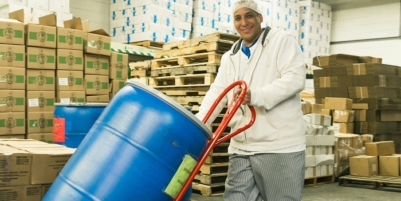-
Nutrivend selects Forterro’s Orderwise to support online expansion and streamline operations - April 11, 2025
-
ARROWXL LAUNCHES AMBITIOUS ZERO WASTE ROADMAP - April 8, 2025
-
THE BCMPA’S NEW CAMPAIGN DRIVES OUTSOURCING SUCCESS IN Q1 - April 7, 2025
-
BLACKOUT TECHNOLOGIES TARGETS TELEMATICS-INTEGRATED MOBILE DEVICE BLOCKING TO COMBAT SMARTPHONE DISTRACTION - April 1, 2025
-
Sparck Technologies awarded Royal designation - March 27, 2025
-
OpenADR Alliance announces first OpenADR 3.0 certified products with EVoke Systems, E.ON Energy and Universal Devices - March 25, 2025
-
Growing fulfilment and contract packer appoints new Managing Director - March 25, 2025
-
When is it time to invest in a WMS? Understanding the key trigger points - March 25, 2025
-
eCapital helps Vantage Recruitment on its journey to financial success - March 24, 2025
-
Hugo Beck Celebrates 70 Years of Packaging Innovation with Open House Events - March 20, 2025
Digital transformation is the process of adoption and implementation of digital technology by an organisation in order to create new or modify existing products, services and operations by the means of translating business processes into a digital format. The goal for its implementation is to increase value through innovation, invention, improved customer experience and efficiency. Focusing on efficiency and costs, the Chartered Institute of Procurement & Supply (CIPS) defines “digitalisation” as the practice of redefining models, functions, operations, processes and activities by leveraging technological advancements to build an efficient digital business environment – one where gains (operational and financial) are maximised, and costs and risks are minimised.
Digital transformation is a broad term and encompasses a wide range of initiatives, including implementing or modernising enterprise resource planning (ERP) and / or warehouse management solutions. While the original concept of digital transformation dates back to the 1960’s business and cultural revolution, decades of research and technology advancement through to today’s AI driven society has brought it back to the forefront of business evolution.
Research backs this up. According to Gartner[lm1] , 91% of businesses are engaged in some form of digital initiative. The analyst group’s 2022-23 State of Digital Adoption report highlights that 67% of enterprises are under ‘huge pressure’ to accelerate their digital transformation programmes, with 87% of senior business leaders saying that digitalisation was a company priority. This is in addition to maintaining the momentum of new product innovation, dealing with cybersecurity, maximising staff retention and generally delivering on all the other ‘business as usual’ targets.
Many companies are implementing ERP and WMS technologies as part of their digital transformation efforts. Without the right solution partner, these projects can be difficult to get right, with potentially high failure rates. For example, Gartner puts a figure on the problem, reporting that between 55% to 75% of all ERP projects fail to meet objectives.
This suggests that a significant number of the businesses attempting ERP and WMS implementations are encountering challenges. Also, whilst all this transformation is taking place the business still has to function and get goods out the door.
Given the intense pressures facing warehouse and supply chain leaders, is it really surprising that these projects can face so many challenges? They have to deliver in a commercial environment where boards are feeling intense cost pressures, time demands, political uncertainty and risk aversion necessity. When people make decisions without fully evaluating all the implications, issues can arise and the consequences can be dire.
How to evaluate investing in a WMS
This article explores best practice approaches to strategic decision making in the warehouse. It explains how to identify which supply chain digital transformation projects to prioritise, the ones to reject, and how to evaluate them objectively. This is a critical balance to achieve because warehouse managers typically have limited resources. They need to know how and why they should be saying ‘yes’ to some projects – like introducing a new WMS. Conversely, they need to know how and why to say ‘no’ to others.
Here are six powerful decision-making models that businesses can use to ensure they strategically evaluate which warehouse digital transformation initiatives to accept or decline.
- Eisenhower Matrix: Urgency vs. Importance
The Eisenhower Matrix helps warehouse managers to categorise tasks based on their urgency and importance, according to four dimensions.
- Urgent and Important: Do immediately
- Important, Not Urgent: Schedule
- Urgent, Not Important: Delegate
- Not Urgent, Not Important: Eliminate.
This is a valuable matrix for warehouse managers to employ when faced with competing priorities, by plotting each task on the relevant matrix quadrant. It is important to focus most attention onto the ‘Urgent and Important’ quadrant but to also schedule time for ‘Important, Not Urgent’ initiatives that may generate longer-term value. For items in the ‘Not Urgent, Not Important’ quadrant, explain how they don’t align with current priorities but could be reconsidered if circumstances change.
2. MoSCoW Method: Prioritising Requirements
This methodology is useful for categorising project initiatives as:
- Must have
- Should have
- Could have
- Won’t have (this time).
When using this method, a collaborative approach works best. For items in the ‘Won’t have’ category, it’s important to acknowledge their potential value but explain how current ‘Must have’ and ‘Should have’ priorities are taking precedence.
3. RICE Scoring Model: Data-Driven Prioritisation
The acronym ‘RICE’ stands for Reach, Impact, Confidence, and Effort. It is a useful model because it provides a very transparent and quantitative approach to prioritisation, thereby removing subjectivity that could be present in the previous two. To use the RICE model, score each potential project according to these four factors and calculate an overall RICE score. RICE scores for competing projects can then be published around the business to demonstrate that some initiatives, for instance implementing a WMS, have scored more highly and should be prioritised.
4. Kano Model: Balancing Customer Satisfaction
The Kano Model is particularly useful because it evaluates a potential digital transformation project according to the perceived value for customers. The rating measures are:
- Must-be: Basic expectations
- Performance: Linear satisfaction increase
- Attractive: Unexpected delighters.
This model helps warehouse managers considering a new WMS to ensure that they are meeting basic customer expectations whilst also investing in innovations that can differentiate your organisation.
5. OKRs (Objectives and Key Results): Aligning with Company Goals
Focusing on OKRs help warehouse managers to align efforts to improve operations with overarching company objectives, therefore ensuring decisions are always evaluated strategically. To use this methodology, ensure all proposed projects clearly link to established OKRs. This helps to maintain strategic focus and eliminates initiatives that don’t contribute to key organisational goals.
6. Pareto Principle (80/20 Rule): Focusing on High-Impact Areas
One of the most well-known decision-making frameworks used in business, the Pareto principle suggests that 80% of results come from 20% of efforts. It’s therefore essential to correctly identify the 20% of projects that are likely to deliver 80% of the value and then prioritise these for maximum impact. If you are introducing a WMS into a warehouse that was previously managed using paper processes, this would automatically be an investment in the 20% category.
In summary if any of the following is applicable to you and / or your business, then a transformative WMS project should already be in your budget.
- Rapid business growth
- too busy to look at a WMS project
- you regularly win new customers,
- 20% of your customers provide 80% of your revenue
- shortage of warehouse staff
- complex orders and / or picking requirements
- moving to a new warehouse
- still using paper pick sheets
- your competition has already transformed their warehouse operation to a new WMS.
Author: Jacky Farrington, Global Customer Success Manager, Indigo Software
[lm1]https://www.gartner.com/en/information-technology/topics/digital-transformation
































